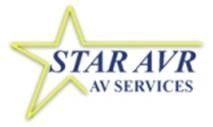CALL US TODAY!
Serving Eastern Pennsylvania Businesses
Since 1998
Pro AV Catalog
Manufacturers
PRODUCT CATEGORIES
Matching Keywords
Model Numbers
Case Study Search
Choose Markets
Choose Applications
clear all
Thank you!
Someone will be in touch with you shortly.
Contact STAR AVR, LLC
close
STAR AVR, LLC
Po Box 31
Old Zionsville, PA 18068
USA
(610)966-0514
www.staravr.com
Po Box 31
Old Zionsville, PA 18068
USA
(610)966-0514
www.staravr.com
USA Inquiries Only
Request more information from a dealer near you
close
Request more information from a dealer near you
Phone:
Fax:
610-966-0556
Email:
Mailing Address:
PO Box 31 Old Zionsville, PA 18068
Content, including images, displayed on this website is protected by copyright laws. Downloading, republication, retransmission or reproduction of content on this website is strictly prohibited. Terms of Use
| Privacy Policy
